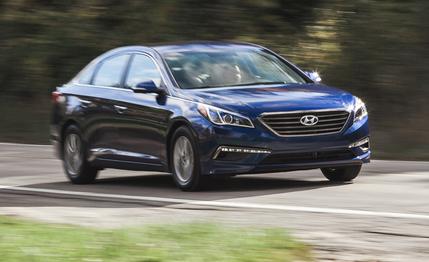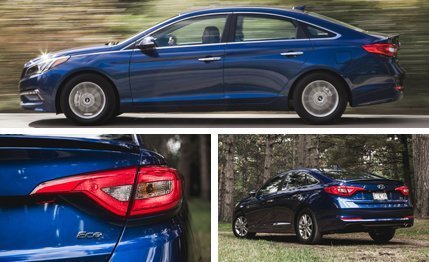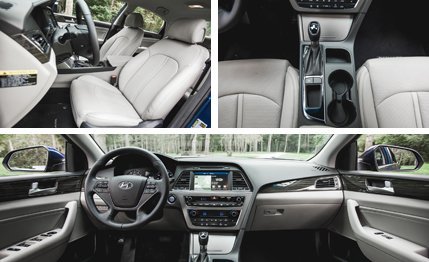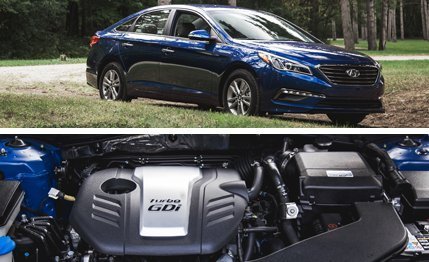 Instrumented Test
Instrumented Test
Aside from its cautious styling—an aside that mystifies many—the latest Hyundai Sonata rolls into 2015 improved in most rating categories, with the addition of a new powertrain that puts this version of the sedan near the head of the mid-size class.
We refer to the new 1.6-liter turbo-four/seven-speed dual-clutch automatic combo that distinguishes the Sonata Eco. It combines solid fuel-economy numbers (28 mpg city, 38 highway, per the EPA) with surprising performance, and it impresses as a smooth operator all around.
The 1.6 isn’t just a destroked version of the 2.0-liter turbo that tops the Sonata power option list. Both are all aluminum, have four valves per cylinder, feature variable valve timing on both cams, and are nourished by direct fuel injection amplified by intercooling and twin-scroll turbochargers.
But whereas the 2.0 is a square design—equal bore and stroke (86 x 86 mm)—the 1.6 is distinctly undersquare, with its 85-mm stroke and 77-mm bore. At max boost (16 psi), this yields a torque curve as broad and flat as Mount Clemens, Michigan, which is exactly as mountainous as a billiard table.
Hyundai’s 1.6 isn’t the most potent of the small-displacement turbo engines huffing around out there. The 1.5-liter Ecoboost offered in the Ford Fusion, for example, is rated for 181 horsepower and 185 lb-ft of torque, and the Ecoboost 1.6 that propels the cheeky little Fiesta ST churns up 197 horsepower and 202 lb-ft.

At 178 horsepower, output of the Hyundai 1.6 is average, but torque—195 lb-ft—is robust, peaking across a plateau that stretches from just off idle to 4500 rpm. It’s easily worth the $925 extra that the Eco commands over a similarly equipped SE with the base engine, a 2.4-liter naturally aspirated four-cylinder. That one makes 185 horsepower but only 178 lb-ft up at 4000 rpm.
It’s not just the engine that improves this experience, though. Unique among mid-size-sedan transmissions—most have six speeds max, including even the Sonata 2.0-liter turbo’s—Hyundai’s new seven-speed dual-clutch automatic makes the most of the 1.6-liter’s output.
At the test track, this adds up to zero to 60 mph in 6.7 seconds and the quarter-mile in 15.3 at 92 mph. For contrast, our test of a 2014 Fusion 1.5 Ecoboost logged 0–60 in 8.2 seconds and the quarter-mile in 16.3 at 85. Much of the difference is attributable to mass; at 3481 pounds, the Ford weighed 184 pounds more than the Hyundai, a stat that bears on fuel economy, too. EPA-rated for 25 city/37 highway, the Fusion managed only 27 mpg in our test, while the Sonata returned a respectable 30, even though we activated its Eco mode infrequently.
But we mentioned surprising, so how about this: The Sonata Eco was 1.3 seconds quicker to 60 mph than the Sonata Sport 2.0T we tested a few months ago, and at 15.3 the Eco was a full second quicker through the quarter-mile. Hyundai has diluted the 2.0T’s output, from 274 to 245 hp (a fuel-economy measure), but this is still supposed to be the hottest setup in the Sonata lineup.
To be fair, that particular 2.0T had a turbo-system hiccup during the testing and may not have been breathing quite properly. Nevertheless, the performance of the 1.6 is impressive—smooth, linear, coming on with a hydraulic surge at the first touch of the pedal, and continuing to deliver through all seven speeds.

One asterisk: Although the transmission up- and downshifts seamlessly in response to throttle demands, it’s awkward to operate manually, achieved by moving the shift lever fore and aft. Paddle shifters are conspicuous by their absence here; Hyundai product planners decided they were inappropriate for a model named Eco. If you want paddles, you must step up to the Sport 2.0T at a starting price $5300 higher. We say paddle shifters and fuel economy are not mutually exclusive concepts.
Beyond its excellent powertrain, the Eco shares the new Sonata’s dynamic virtues: A unibody markedly stiffer than that of the previous generation; suspension tuning that strikes a just-right balance between Euro firm and family friendly; and electric power steering that’s quick (2.8 turns lock-to-lock) and commendably tactile.
Like all front-drive sedans, the Sonata resists turn-in when curves arrive quickly; with pronounced forward weight bias (60.6/39.4 front/rear) and front tires required to transmit power to the pavement while handling cornering loads, its limits come early.
Would stickier rubber help? Almost certainly. This Sonata Eco rode on a set of Hankook Kinergy GT all-season tires (205/65R-16), which can be provoked into shrieks without much effort and which limit skidpad performance to 0.81 g—not terrible by mid-size-sedan standards but not good, either. These tires also figure in lamentable braking performance—185 feet to stop from 70 mph.
Nevertheless, the Sonata Eco is among the better family sedans to drive, augmented by exceptionally quiet operation; a roomy, nicely appointed interior; and, as usual with a Hyundai, an extensive inventory of standard features.

Our test car was enhanced by one major option group—the $4100 Tech package, which includes navigation with an 8.0-inch center-dash display, electroluminescent instruments, premium audio, leather seats, heated front seats, dual-zone automatic climate control, a leather-wrapped steering wheel, and blind-spot warning.
Controls are well marked and logically placed, with a nice array of good ol’ knobs and switches to augment touch-screen functions. The telematics and infotainment are comprehensive—pretty much the norm nowadays—and if the simulated wood trim looks like it was harvested on some other planet, interior materials are quietly high quality.
The bold exterior of the previous Sonata gave Hyundai a presence in the mid-size-sedan market that it had never enjoyed before, and it inspired other carmakers to shake off their caution. The extensively freshened Toyota Camry is the latest example. So we have trouble understanding Hyundai’s stylistic retreat with the new generation. The company calls it a more “mature” treatment, which we translate as timid.
Nevertheless, this is a better Sonata than its predecessor. And if its blend of comfort, solid structure, quality materials, rewarding dynamics, and solid value appeal to you, the Eco could be the sweetest Sonata in the music room.